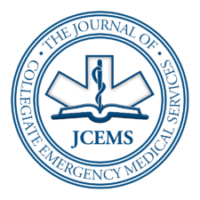Poster Presentation Abstract
Introduction: One of the most important decisions a first-responder agency operating under Basic Life Support (BLS) jurisdiction can make is determining whether a medical emergency can be managed at the BLS level, or if additional resources must be requested in the form of Advanced Life Support (ALS) to facilitate transport to a hospital. This is particularly important in collegiate agencies, as not all may have the means or equipment to transport ALS patients. Studies show that ALS is beneficial in certain scenarios that BLS providers cannot treat effectively such as epileptic episodes or respiratory distress. This decision on whether to upgrade to ALS is based on several factors: patient demographics, the acuity and severity of the medical complaint, and provider-obtained metrics of health.
Methods: In this study, we examined the vital signs of patients (n = 357) at the University of Texas at Dallas, obtained by providers from the University Emergency Medical Response (UEMR) agency, and compared them to the established agency and local standards of upgrading to ALS.
Results: Compared to the national refusal rate of 5.1%, the refusal rate of UEMR is approximately seven times higher, which may be explained by the unique patient demographics found on college campuses. Through mono- and bi-factor analysis, we determined that there is a negligible correlation between the presence of abnormal vital(s) and ALS upgrade for a collegiate Emergency Medical Service (EMS) organization. Per UEMR Protocols, only 42% of patients presenting with an abnormal heart rate with normal rhythm, and 38% presenting with abnormal blood pressure, were upgraded to ALS, while only a slightly fewer number (~30%) were upgraded without abnormal vital indication. Furthermore, our research showed that out of all medical calls a provider did determine that ALS upgrade was required, only 31% of those patients presented with abnormal vitals, compared to about 24% of patients that presented with similarly abnormal vitals but were determined not to require an ALS upgrade.
Discussion/Conclusions: Due to the unique demographics and socioeconomic factors prevalent in a college patient population, this discrepancy, in contrast to traditional rural and urban EMS programs, indicates the changing role of vital signs as a diagnostic tool, rather than an inflexible reference point. Additionally, an internal poll of the UEMR members found that only 12% of providers have more than three years of experience and 21% having significant patient care experience outside of the organization itself. Inexperience tends to manifest in increased reliance on established protocols rather than a more holistic overview of the patient. This highlights the need for collegiate EMS organizations that have not yet reached internal ALS-transport capacity, to further examine vital sign assessments, and their inherent limitations against a general population, which is necessary to create and enforce effective healthcare protocol prior to and in the transference of medical care.
View Poster (PDF)
Author & Article Information
Author Affiliations: From University Emergency Medical Response at University of Texas at Dallas – in Dallas, TX, USA (A.Q., Y.P. & T.G.).
Address for Correspondence: Alexander Quach | Email: alexander.quach@utdallas.edu
Conflicts of Interest/Funding Sources: By the JCEMS Submission Declaration Form, all authors are required to disclose all potential conflicts of interest and funding sources. The authors declared that they have no conflicts of interest. The authors declared that they did not receive funding to conduct the program or research associated with this work.
Ethical Compliance: The authors attest that the research associated with this abstract was conducted in accordance with the JCEMS Ethics Guidelines.
Submission History: Submission History: Received December 31, 2019; accepted for presentation and publication February 13, 2020.
Poster Presentation: This abstract was presented as a poster at the Academic Poster Session of the 27th Annual Conference of the National Collegiate Emergency Medical Services Foundation; February 29, 2020; Boston, MA, USA. The authors received the Third Place Award in the Poster Presentation Competition.
Published Online: December 31, 2020
Published in Print: December 31, 2020 (Volume 3: Issue 2)
Reviewer Information: In accordance with JCEMS editorial policy, poster presentation abstracts undergo double-blind peer-review by at least two reviewers (JCEMS Editorial Board members and/or independent reviewers) prior to acceptance for presentation and publication. JCEMS thanks the anonymous reviewers who contributed to the review of this work.
Copyright: © 2020 Quach, Peng & Gawronski. This is an open access article distributed under the terms of the Creative Commons Attribution 4.0 International (CC BY 4.0) License, which permits unrestricted use, distribution, and reproduction in any medium, provided the original author and source are credited. The full license is available at: https://creativecommons.org/licenses/by/4.0/
Electronic Link: https://doi.org/10.30542/JCEMS.2020.03.S1.03








